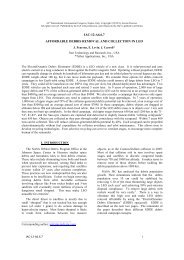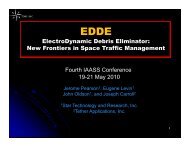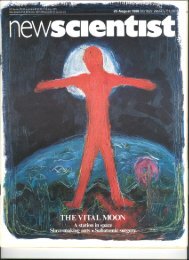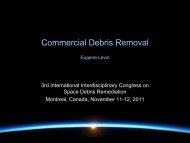The Cost of Future Collisions in LEO - Star Technology and Research
The Cost of Future Collisions in LEO - Star Technology and Research
The Cost of Future Collisions in LEO - Star Technology and Research
Create successful ePaper yourself
Turn your PDF publications into a flip-book with our unique Google optimized e-Paper software.
4<br />
1. Introduction<br />
It is now recognized that a s<strong>in</strong>gle catastrophic collision between <strong>in</strong>tact objects <strong>in</strong><br />
<strong>LEO</strong> can negate many years <strong>of</strong> debris mitigation efforts. We will see below that<br />
an average catastrophic collision is likely to be on the scale <strong>of</strong> the Fengyun-1C<br />
<strong>and</strong> Cosmos–Iridium events comb<strong>in</strong>ed. <strong>The</strong>y produced on the order <strong>of</strong> 400,000<br />
fragments <strong>in</strong> the centimeter range (“shrapnel”), an amount comparable to the accumulation<br />
<strong>of</strong> explosion fragments over 50 years <strong>of</strong> spaceflight. <strong>The</strong>se fragments<br />
are currently untracked <strong>and</strong> impossible to avoid, but they can disable or seriously<br />
damage operational satellites. <strong>The</strong> full extent <strong>of</strong> <strong>LEO</strong> pollution result<strong>in</strong>g from five<br />
decades <strong>of</strong> space activities <strong>and</strong> various unplanned events will be more obvious when<br />
small fragments become trackable with new observation techniques <strong>in</strong> the future. In<br />
this new world, the everyday task <strong>of</strong> collision avoidance will be much more difficult<br />
due to the sheer number <strong>of</strong> objects to avoid, <strong>and</strong> the task <strong>of</strong> debris removal will<br />
look much more urgent.<br />
In order to prevent further <strong>LEO</strong> pollution with more fragments produced <strong>in</strong><br />
catastrophic collisions, large debris objects, the primary source <strong>of</strong> future “shrapnel,”<br />
should be removed from densely populated regions <strong>in</strong> <strong>LEO</strong> [1,2,3]. <strong>The</strong>re is a range<br />
<strong>of</strong> op<strong>in</strong>ions on how many objects should be removed annually. NASA has been<br />
conservatively suggest<strong>in</strong>g removal <strong>of</strong> five large objects per year [1], assum<strong>in</strong>g 90%<br />
post-mission disposal compliance, while ESA has <strong>in</strong>dicated that there may be a need<br />
to remove up to 27 objects per year <strong>in</strong> some scenarios [2]. <strong>The</strong>se campaigns would<br />
be long-term <strong>in</strong> nature, <strong>and</strong> it would take a very long time to get rid <strong>of</strong> the 2,200<br />
large debris objects currently <strong>in</strong> low Earth orbits. Dur<strong>in</strong>g this time, catastrophic<br />
collisions <strong>and</strong> production <strong>of</strong> “shrapnel” will cont<strong>in</strong>ue. <strong>The</strong> authors <strong>of</strong> this paper<br />
recently argued <strong>in</strong> favor <strong>of</strong> a short-term wholesale debris removal campaign [3], <strong>in</strong><br />
which electrodynamic “garbage trucks” <strong>of</strong> the latest design could remove several<br />
hundred objects per year at a very reasonable cost, <strong>and</strong> <strong>LEO</strong> could be mostly free<br />
<strong>of</strong> large debris objects <strong>in</strong> a decade or so. In this scenario, catastrophic collisions<br />
will become very unlikely, <strong>and</strong> practically no more “shrapnel” will be produced.<br />
Before decisions can be made on debris removal campaigns, we need to better<br />
underst<strong>and</strong> <strong>and</strong> evaluate the potential impact <strong>of</strong> future catastrophic collisions on<br />
operational spacecraft. One <strong>of</strong> the pioneer<strong>in</strong>g studies <strong>in</strong> this area was undertaken<br />
by the Aerospace Corporation [4]. <strong>The</strong> study evaluated added costs <strong>of</strong> operat<strong>in</strong>g<br />
three types <strong>of</strong> constellations <strong>in</strong> a gradually deteriorat<strong>in</strong>g <strong>LEO</strong> environment. <strong>The</strong><br />
exist<strong>in</strong>g models <strong>of</strong> the <strong>LEO</strong> debris environment, such as ORDEM, MASTER, <strong>and</strong><br />
others, could be used for such evaluations, however, they are rather complex due<br />
to the level <strong>of</strong> detail <strong>and</strong> not easy to apply <strong>in</strong> analytical studies. In addition, their<br />
implementations are numeric, <strong>and</strong> details <strong>of</strong> these implementations are not publicly<br />
available. In this paper, we formulate a relatively simple analytical model <strong>and</strong> apply<br />
it to the evaluation <strong>of</strong> the cost <strong>of</strong> future collisions <strong>in</strong> <strong>LEO</strong>.








